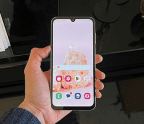Best phablet phones

Phones used to be small: the first Samsung Galaxy S had a 4in display that looks tiny by today’s standards. In contrast to this, the new Galaxy Note10+ has a massive 6.8in screen, and it isn’t the only phone with one that size. If you’re looking for a handset with a large display to stream the latest TV shows, watch a movie or play a game, then read on for our top recommendations.
1. OnePlus 7 Pro
Price: £699 from fave.co/2Iiqzgf
The near-meteoric rise of OnePlus has in large part been thanks to a pretty clear strategy: offer the most important features of the year’s biggest flagships, minus the flashy fluff, at a fraction of the price. With the OnePlus 7 Pro, that all changes.

The 7 and 7 Pro phones mark the first time that OnePlus is releasing two phones at once: the 7 is the natural next step from last year’s 6T, while the 7 Pro is a step up from that. It’s a full-blooded flagship, OnePlus throwing the gauntlet down and trying to prove once and for all that it can make phones to rival the likes of the Galaxy S10 or Huawei P30 Pro if it wants to. And on the strength of the 7 Pro, the company clearly can.
I’ve been using the 7 Pro for over a week, and I have been seriously impressed. The core OnePlus ethos is still present, but backed up by better specs focused on two of the areas of the phone people really use the most: the camera and the screen.
Display
Easily the first thing you’ll notice about the 7 Pro is the display, which excels in just about every way it is possible for a smartphone screen to excel.
Size? A whopping 6.67in. Refresh rate? A smooth 90Hz. Resolution? QHD+ – or 3,120x1,440 to be precise. I could go on: colour range, pixel density, curved edges, HDR, Gorilla Glass 5 – on paper this is one of the best panels you’ll find in a smartphone today, and it’s entirely uninterrupted by a notch.
The 90Hz refresh rate is perhaps the most welcome new feature. Mostly limited to gaming phones like the Razer Phone or Asus’s ROG Phone before now, higher refresh rates smooth out animations across the board, leaving every interaction with the phone feeling faster and more fluid.
It’s a change that’s hard to put your finger on at first, but flick between the 60- and 90Hz options and you’ll quickly realize that just about everything you do with the phone feels smoother – not to mention the benefits it brings when playing games or watching content that can make the most of the refresh rate.
There’s a battery drain, of course, so if you prefer you can drop down to 60Hz – and smartly, even while on this mode the phone will still jump up to 90Hz when you’re, say, playing a game that can make the most of it before dropping back down to 60Hz for your day-to-day stuff.
There’s once again an in-display fingerprint sensor hidden below the surface, though it’s improved from the 6T. OnePlus says it should be almost twice as fast thanks to an upgraded lens and larger sensor area, and it definitely feels it. It still failed to spot my thumb a few times too often, but it feels like this is almost as good as a dedicated physical scanner, which is the highest praise it could hope to get.
Throw in the giant resolution, curved edges (with palm rejection to avoid accidental presses) and support for HDR10+ across both YouTube and Netflix, and it’s clear that this screen is something special indeed.

Those curved edges help the phone feel slim – though at 8.8mm it’s not the absolute thinnest device around – while the Gorilla Glass 5 protection extends to the rear as well. This comes in one of three finishes: Mirror Grey, Nebula Blue (pictured above), and Almond. The blue in particular is stunning, with a slightly matte effect to the gradient design, while Almond is a creamier take on Apple’s Gold iPhones.
Of course, I can’t talk about the display or the design without addressing the notch – or rather, the lack thereof. The 7 Pro is one of the latest proper full-screen phones to hit the west, in this case by shifting the selfie camera into a small slider that pops up when needed, and retracts just as quickly.

Fall detection means it withdraws if you accidentally drop the phone, and naturally OnePlus assures us it’s tested the mechanism hundreds of thousands of times for durability’s sake. It works for face unlock too, and is astonishingly quick there – the camera retracts almost as soon as it’s opened, so it is still a split-second process.
Cameras
The selfie shooter isn’t the only exciting camera here, though. Beyond the novel design, that one isn’t all that exciting otherwise: it’s a similar 16Mp camera to the one found in the 6T, just in a new spot.
More interesting are the cameras
You’re reading a preview, subscribe to read more.
Start your free 30 days





